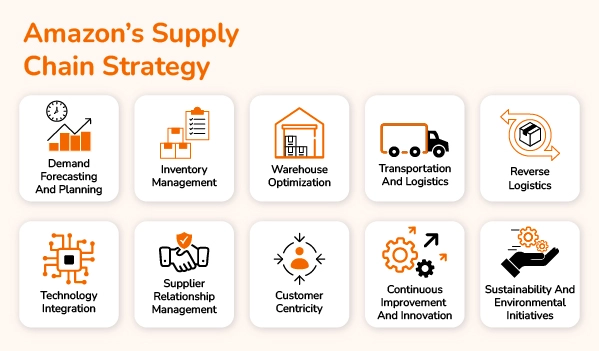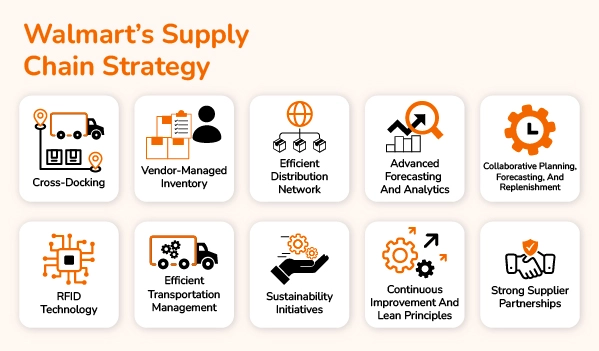10 Highly Efficient Strategies Employed by Amazon in Supply Chain Management

Introduction:
Supply chain management plays a vital role in the success of businesses, ensuring smooth operations, cost efficiency, and customer satisfaction.
What is SCM?
Supply chain management (SCM) is a comprehensive system that encompasses the coordination and management of all activities involved in the flow of goods and services, from raw material sourcing to the delivery of the final product to the end customer. It involves the integration and optimization of key components, functions, and processes to ensure the smooth and efficient operation of the entire supply chain network.
Key components of supply chain management:
- Suppliers: The partners or entities that provide the necessary raw materials, components, or services required for production.
- Manufacturers: The organizations responsible for transforming the raw materials into finished goods or products.
- Warehouses and Distribution Centers: Facilities used for storage, inventory management, and order fulfillment to ensure timely delivery.
- Transportation: The movement of goods and materials between various locations in the supply chain network.
- Retailers: The final link in the supply chain, responsible for selling the products to the end customers.
Supply chain management strategies used by Amazon

Demand Forecasting and Planning:
Accurate demand forecasting and planning are crucial for efficient supply chain management. Amazon excels in this aspect by utilizing advanced algorithms and data analytics to forecast customer demand. This ensures optimal inventory levels, minimizes out-of-stock situations, and improves customer satisfaction.
Inventory Management:
Amazon employs techniques such as Just-in-Time (JIT) and Vendor Managed Inventory (VMI) systems to optimize stock levels and reduce overhead costs. By closely monitoring sales patterns and real-time data, Amazon ensures that inventory is replenished at the right time and in the right quantities.
Warehouse Optimization:
Amazon's innovative warehouse designs employ robotics and automation for efficient order picking and fulfillment. These technologies enable rapid processing, accurate inventory tracking, and faster order delivery, ultimately enhancing the customer experience.
Transportation and Logistics:
Amazon has an extensive network of fulfillment centers strategically located for efficient transportation. Collaborations with logistics providers and the use of advanced route optimization algorithms ensure timely and cost-effective delivery, even during peak seasons.
Reverse Logistics:
To enhance customer satisfaction and reduce waste, Amazon has well-defined reverse logistics processes. Efficient product returns, refurbishment, and reselling techniques ensure minimal disruptions, improved customer experience, and reduced environmental impact.
Technology Integration:
Amazon leverages cutting-edge technologies like the Internet of Things (IoT) and Artificial Intelligence (AI) in its supply chain management. Real-time data tracking, predictive analytics, and automation streamline operations, reduce errors, and enable proactive decision-making.
Supplier Relationship Management:
Amazon recognizes the importance of strong supplier relationships based on trust and transparency. By fostering collaboration and effective communication, Amazon ensures enhanced supplier performance, higher product quality, and lower costs.
Customer Centricity:
Amazon's customer-centric approach is at the core of its supply chain management strategies. Initiatives like same-day delivery, personalized recommendations, and hassle-free return processes create a seamless and satisfying customer experience.
Continuous Improvement and Innovation:
Amazon's commitment to continuous improvement and innovation is evident in its supply chain management practices. They constantly refine processes, test new technologies, and learn from customer feedback to enhance efficiency and stay ahead of competitors.
Sustainability and Environmental Initiatives:
Amazon integrates sustainability into its supply chain management practices. It focuses on using renewable energy, implementing eco-friendly packaging, and reducing its carbon footprint. These initiatives align with their values and contribute to a more sustainable future.
Supply chain management strategies used by Walmart

Cross-Docking:
Implementing a cross-docking strategy enables Walmart to streamline its supply chain by bypassing the need for inventory storage. Goods are delivered directly to distribution centers and quickly sorted for immediate shipment to stores. This minimizes inventory holding costs and improves overall efficiency.
Vendor-Managed Inventory (VMI):
Walmart collaborates closely with its suppliers through the implementation of Vendor-Managed Inventory. Suppliers have access to real-time data, allowing them to monitor inventory levels and replenish stock as needed. This strategy helps Walmart maintain optimal inventory levels by reducing stockouts and excess inventory.
Efficient Distribution Network:
Walmart boasts an extensive distribution network strategically placed for maximum efficiency. By strategically locating its distribution centers close to suppliers and stores, Walmart reduces transportation costs, delivery times, and ensures prompt inventory replenishment.
Advanced Forecasting and Analytics:
Walmart utilizes advanced data analytics to accurately forecast customer demand, enabling the company to optimize its inventory levels and manage stock accordingly. This data-driven approach ensures that Walmart can promptly restock popular items and minimize the risk of overstocking less popular ones.
Collaborative Planning, Forecasting, and Replenishment (CPFR):
Through collaborative planning, forecasting, and replenishment, Walmart shares sales data with suppliers, allowing both parties to align their production and distribution schedules. This streamlined approach reduces lead times, optimizes supply chain efficiency, and ensures product availability.
RFID Technology:
Walmart employs RFID (Radio Frequency Identification) technology to track and monitor product movement throughout its supply chain. This efficient tracking system improves inventory accuracy, reduces shrinkage, and enhances overall supply chain visibility.
Efficient Transportation Management:
Walmart's transportation strategy focuses on optimizing the movement of goods between suppliers, distribution centers, and stores. By utilizing state-of-the-art routing algorithms and consolidating shipments, Walmart minimizes transportation costs, reduces delivery times, and enhances overall efficiency.
Sustainability Initiatives:
Walmart's commitment to sustainability extends to its supply chain management. The company works closely with suppliers to promote sustainable practices and reduce waste. By implementing initiatives such as advanced packaging designs and energy-efficient transportation options, Walmart minimizes its environmental footprint while improving supply chain efficiency.
Continuous Improvement and Lean Principles:
Walmart consistently applies lean principles to improve its supply chain operations. By eliminating waste, optimizing processes, and constantly seeking innovative solutions, Walmart remains at the forefront of supply chain management practices, ensuring maximum efficiency and cost-effectiveness.
Strong Supplier Partnerships:
Walmart places great emphasis on building strong relationships with its suppliers. By forging long-term partnerships, Walmart can negotiate better prices, improve reliability, and collaborate on supply chain optimization initiatives. This collaborative approach ensures a smooth flow of goods, enhances communication, and drives overall supply chain efficiency.
Conclusion
Amazon's supply chain management strategies have played a crucial role in its success as a global leader. By employing efficient demand forecasting, inventory management, warehouse optimization, transportation and logistics, reverse logistics, technology integration, supplier relationship management, customer centricity, continuous improvement, and sustainability initiatives, Amazon sets a benchmark for other businesses to follow. By implementing some of these strategies, businesses can enhance their supply chain management and emulate Amazon's success.
Walmart's success as a retail giant can be attributed in large part to its cutting-edge supply chain management strategies. By leveraging cross-docking, VMI, advanced analytics, RFID technology, and other innovative approaches, Walmart has established itself as an industry leader in supply chain efficiency. Adopting these strategies can provide valuable insights to businesses looking to optimize their own supply chain operations and enhance them.



